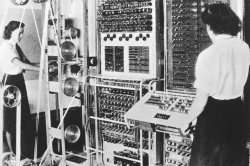One of the most famous code-breakers is the Colossus – used by the British during World War Two to break German signals intelligence. Credit: TopFoto/HIP.
Oxford theorists and their Cambridge collaborator have moved a step closer to creating a machine that would fully harness the deepest laws of physics, quantum mechanics. The machine, called a quantum computer, would have a range of potential uses – including code breaking. It could exactly simulate the behaviour of matter at the atomic scale, providing new insights to chemists and biologists.
Quantum dots – tiny nuggets of one material embedded inside another – could be the ideal building blocks for a quantum computer. However, in order to build such a device, it is necessary to create ‘entanglement’ between different dots, a phenomenon labelled ‘spooky’ by Einstein and the essential resource that would give a quantum computer its power.
In Physical Review Letters, Oxford student Avinash Kolli and his coauthors suggest a new way to create entanglement, by identifying two different stable states of a quantum dot (call them ‘A’ and ‘B’) and then targeting two such dots simultaneously with a laser.
The team discovered that, by watching the light emitted back from the dots, they would learn exactly one piece of information – namely, whether the two dots are in the same state as one another (AA or BB) or different states (AB or BA).
Crucially, this is the only piece of information that would come back. If the two dots are in different states, and if there really is no further information, then nature itself has absolutely no evidence indicating which is A and which is B. This would mean that the actual state of the two dots would be both AB and BA at the same time.
This strange state is a so-called quantum superposition. It is also an entanglement between the dots – the maximum possible degree of entanglement in fact.
Avinash Kolli said: ‘So, simply by illuminating the two dots with a laser and watching the light they emit, entanglement can be created – the elusive resource that will make quantum computation possible.’
A lot of work still needs to be done to flesh out this idea into a full blueprint for a quantum dot computer, but the predictions are testable with existing laboratory equipment. The team is now looking for experimentalists to collaborate on testing this proposal.
Source: University of Oxford
























